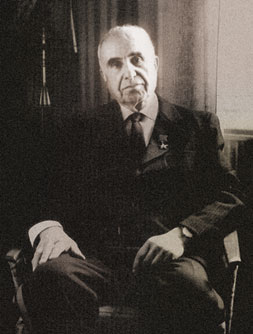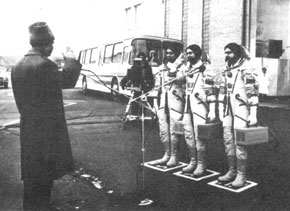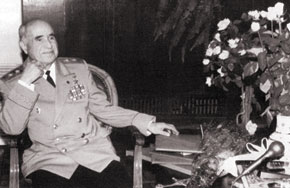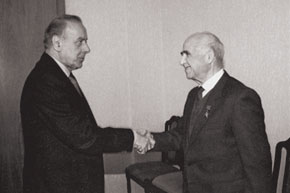 Karim Karimov (1917-2003) was a major contributor to the development of the USSR’s space programme. For a quarter of a century, as chairman of the State Commission of the USSR, he exercised control of test flights for spaceships. All this time his work was rated top secret and so all information about Karimov´s life was also a state secret. Only in the late 1980s, with a greater degree of openness in the USSR, did Karimov and his activities receive some public attention. Later a book was written about his life and work: The Way to Space: Notes of the Chairman of the State Commission for Space Flights, and published in 2009. As we considered publishing an article about Karimov we turned to this book. Luckily enough, Karimov wrote an introduction to this comprehensive volume, called About Me Briefly, in which he covered the main events of his life. In a short article he covered his fascinating life story in fine style. Thus, we present a translation of his story as he wrote it.
Karim Karimov (1917-2003) was a major contributor to the development of the USSR’s space programme. For a quarter of a century, as chairman of the State Commission of the USSR, he exercised control of test flights for spaceships. All this time his work was rated top secret and so all information about Karimov´s life was also a state secret. Only in the late 1980s, with a greater degree of openness in the USSR, did Karimov and his activities receive some public attention. Later a book was written about his life and work: The Way to Space: Notes of the Chairman of the State Commission for Space Flights, and published in 2009. As we considered publishing an article about Karimov we turned to this book. Luckily enough, Karimov wrote an introduction to this comprehensive volume, called About Me Briefly, in which he covered the main events of his life. In a short article he covered his fascinating life story in fine style. Thus, we present a translation of his story as he wrote it.About Me Briefly
by Karim Karimov
I was born in November 1917, in Baku, the capital city of Azerbaijan, into the family of an engineer, Abbasali Karimov. I spent my childhood and youth in that city.
My father worked in the oil industry, after graduating from the Polytechnic Institute in St. Petersburg. My mother, Suriya Karimova (Ahmadova), finished gymnasium school and got married. She was busy with household chores as a housewife. Besides me, my parents had two other children: Suleyman was born in 1921 and Mustafa was born in 1923. We lost our mother too early. She died the same year I went to school, in 1925. Our father did not marry again. After my mother died, my father brought us up and concentrated on our education. My mother’s parents helped my father to bring us up.
After finishing secondary school I entered the Azerbaijan Industrial Institute (now the Oil Academy) in the Faculty of Energy. I married very early, while I was still in my first year of study and I started work during my student years. My job was in radio engineering. I had been fascinated by this new technology ever since childhood and was able to assemble and repair radio equipment with ease.
I was 20 years old when my daughter was born. My wife and I named her after my late mother. My wife suspended her education because of the child. She was able to continue her education after our daughter went to school.
The Second World War began. In the first months of the German occupation, my brother Suleyman was killed in one of the bloodiest battles. Mustafa was soon called up to the front. He was an anti-aircraft gunner. At the beginning of 1942 I graduated from the Institute’s faculty of engineering. As an engineer-electrician I was sent to the Artillery Academy where we were mainly taught military subjects. I graduated from there at the end of 1943 with the rank of Lieutenant-technician and was a qualified artillery technician.
 The board of Soyuz TM-4 reporting on preparations to Lieutenant-General Karimov, Chair of the State Commission. 1987
The board of Soyuz TM-4 reporting on preparations to Lieutenant-General Karimov, Chair of the State Commission. 1987 A career in rockets launched
After graduation from the Academy, I was sent to the Head Office of the Guards Mine Thrower Military Units in Moscow. I was in charge of approval procedures for military equipment from plants producing rocket launchers – Katyusha. The rocket launchers were sent from the plants directly to the front after they were approved. I wanted to move my family to Moscow, but I only could do so after the end of the war in 1945.
After the end of the World War II, I was awarded the Order of the Red Star and was retained in the army and sent to serve in the central office of the Ministry of Defence. I was there for more than twenty years, in various positions from Senior Engineer to Chief of the Office of Space Facilities. In 1946, I was sent with a group of rocket engineering experts on a mission to the German towns of Nordhausen and Bleicherode in Thuringia to study the German rockets left after the war. We brought FAU-2 ballistic rockets to Russia and carried out test flights. Later we used data obtained from this experience in the development and production of strategic ballistic rockets. A team headed by D.F. Ustinov did this work. (Dmitriy Fyodorovich Ustinov later became Minister of Defence of the USSR (1976-84) – Ed.)
When I was in Germany, the German radio-measuring systems Messina–1 and Messina-2 attracted my attention. They had been developed for the remote control of a rocket’s parameters. A little later, in 1950, I was awarded the Stalin Prize, along with other experts, for my participation in the development and operation of the Don domestic radio-measuring system. Radio-measuring devices were very helpful in the detection and correction of unseen defects in rockets. This accelerated launch preparations.
As I was chief of the contracting office in the military administration, I was appointed Chairman of the State Commission implementing satellite test flights. These satellites were intended for two tasks: Molniya-1 was for communications and Meteor for meteorological work and surveying the Earth. As time went on our tests became more successful. We managed to find and eliminate the defects.
Masterminding manned space
A large group of experts who took an active part in the development and implementation of man´s first flight into space in 1961 was awarded important prizes by the state. I was given the Order of Lenin and the high military rank of Major General.
The historic space flights by Soviet cosmonauts and US astronauts led to further development in space vehicles. In 1965, industrial ministries were established in the USSR. I was asked to lead the Main Space Office of the Ministry of Mechanical Engineering responsible for the future development of space rockets and technology. I was appointed a member of the ministry´s board and Head of the Main Office, while still a member of the Armed Forces.
All the major design bureaus and plants engaged in developing carrier rockets and spaceships were assigned to our office. We were given major, challenging tasks. One of the most important and more difficult was the development of automatic machines to study the planets of the solar system and the moon. The Design Office was led by Sergei Pavlovich Korolev (1906-1966). He was a well-known expert in the field of astronautics. Under his leadership the first artificial satellite was launched and the first manned flight into space took place. He was released from all other duties and was involved in the development of capsules and rockets for studies of space. The N-1 was developed to investigate the moon and planets; its basic weight was 2,000 tons. However, Nikita Sergeyevich Khrushchev divided the funds allocated by the government for space research. He established a new Design Office under the management of Vladimir Nikolayevich Chelomey (1914-1984). He was an expert in the field of mechanics and management processes. The Design Office began to repeat the work of Korolev’s team.
Setbacks
The UR-500 rocket was basically four times lighter than the N-1 rocket. While the latter had the capacity for a flight to the moon, the UR-500 rocket did not. Instead it was presented to the public as a military rocket and was developed at the request of the Ministry of Defence. The UR-500 rocket was given the green light from the very outset. All engine and device units being designed for the N-1 rocket were re-directed to the UR-500 rocket.
Despite the complex, heavy equipment of the N-1 and Korolev’s sudden death, our office made a concerted effort and succeeded in preparing this rocket for test flights. However, the failures that occurred during tests and the lack of funds for designing two powerful rocket carriers at the same time, led first to the postponement of N-1 rocket test flights and then to their complete suspension.
However, the experience gained during the development of the N-1 rocket by the Design Office, which was now named after Korolev, was not wasted. Our data was used later by the rocket builders developing the powerful, modern Energy rocket that operated on cryogen fuel components and had a basic weight of 2,000 tons. This had been Korolev’s dream.
Again, I want to go back a little. As I mentioned, as work on the N-1 rocket was halted, we had had to continue space research using the UR-500 rocket. We used cryogen fuel to boost its speed. In addition, we managed to involve the Lavochkin plant and the Design Office, which by that time were free of military orders, in the designing of automatic equipment for the study of the moon and planets.
Successes
Unique research was carried out with equipment downloaded to the surface of Venus. Rock samples brought from the moon to Earth with the help of automatic equipment caused great excitement. All the staff under Georgi Nikolayevich Babakin (1914-71) were awarded the highest state prizes. The management of the Ministry and of the Head Office were among those awarded. A little earlier, I had been awarded the Lenin Prize for participation in the design of an oriented satellite for surveying the Earth. In those years our office, as well as carrying out the investigation of the moon and planets by robot equipment, was also speedily mastering the production of manned space capsules, Soyuz, in the experimental plant of the Korolev Design Office. By decision of the government in 1966, I was appointed Chairman of the State Commission implementing the test flights of these spaceships. I occupied this position for 25 years.
Soyuz and Salyut
Vasily Mishin, Valentin Glushko and a corresponding member of the Academy, Yuri Semenov, were appointed to the positions of Deputy Chairman and engineering managers of the State Commission. Flight training of the single-seat Soyuz capsule underwent a long and tragic testing period. Despite a series of setbacks, as well as the tragic deaths of astronauts Vladimir Komarov in the Soyuz-1 capsule in April 1967, and Georgi Dobrovolsky, Vladislav Volkov and Viktor Patsayev in the Soyuz-11 capsule in June 1971, the tests ended with a successful combination of capsules in orbit and with the establishment of the Salyut orbital station following these tests. I was awarded the rank of Lieutenant-General in 1967 for my participation in the implementation of the first automated combination of the Soyuz ships and on the occasion of my 50th birthday. In 1979, for the successful implementation of a series of international flights of the orbital station, I was given the State award.
In 1972, my wife Zahra died after a long illness, and I had to live with my daughter’s family. My daughter is a Doctor of Engineering and is Head of the Department of Space Geodesy at the Institute of Astronomy of the Russian Federation Academy of Sciences. In 1974 I was appointed First Deputy Director of the Central Scientific Research Institute while I was still Chairman of the State Commission on space flights. In 1987 I was awarded the Order of Lenin for the second time, as well as the Gold Star medal, and was awarded the title of Hero of Socialist Labour for the establishment of the Mir (Peace) station, the implementation of a successful series of flights of combined and international crews to the station as well as on the occasion of my 70th birthday.
After retirement in 1991, I was engaged in the implementation of space flights and worked as a consultant in the Centre of Flight Management (CFM).




